Racquetball is indeed a game of wonderful excitement.
Here we are to discuss a brief history of racquetball, tips and tricks for beginners as well as advanced level players, and racquetball equipment, including a racquetball court, ball, eye guards, gloves, etc.
Let’s move ahead!
Racquetball: Brief History, Equipment, Skills & Techniques of Playing
Contents
Racquetball was invented by a multi-talented and professional squash, tennis, and handball player Joseph G. Sobek, in 1950, in Greenwich YMCA, USA. Joseph G. Sobek originally called this game paddle racquet.
But it’s sometimes referred to as ‘American Racquetball’.
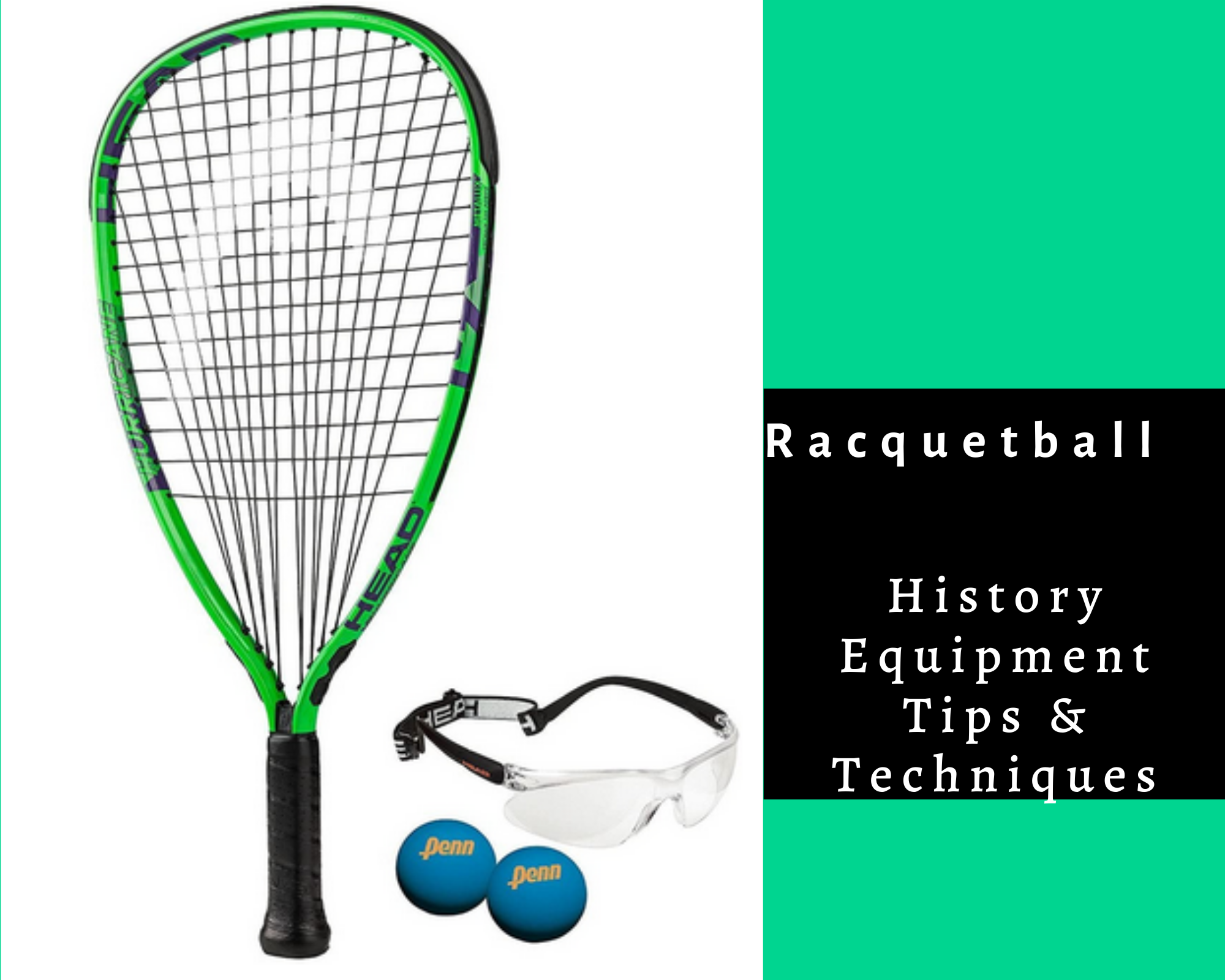
As per records, Joseph Sobek was not happy with the dearth of indoor sports in his time, so he tried to invent an easy as well as fast playing game that could attract and entertain him and other people around him.
He is credited with the invention of the first-ever stringed paddle (racquet).
Being a player of different games, he adapted some elements of squash, handball, and paddle ball and devised the rules of this fascinating game. Sobek is also credited with the foundation of the National Paddle Rackets Association in1952.
With Sobek’s ever-increasing success and ascendancy, this sport gained fast fame and name.
The soaring popularity of this game encouraged Robert Kendler to found the International Racquetball Association (IRA) in 1969. This foundation led to the change in the name of this game, and it became racquetball.
It was 1974 when the first-ever professional tournament was held by IRA. Consequently, the first governing body of racquetball turned into the founding member of the International Racquetball Federation (IRF).
In 1980, women were blessed with the foundation of their independent association, namely, The Women Professional Racquetball Association.
By the later decades of the 20th century, racquetball had acquired immense popularity in the USA.
Keeping in mind the fast-growing popularity, the first racquetball world championship was organized in 1981 USA.
Equipment Needed to Play Racquetball Sport
Following are the essential equipment that you definitely need to play racquetball sport
1. Racquetball Racquets
It may go without saying that your racquetball racquet is the most important piece of equipment that you will buy for this sport. But with so many options to choose from, it can be a difficult decision to make.
We’ve outlined some of the most important features so you can be playing in no time.
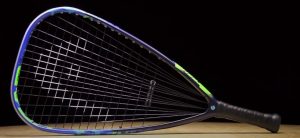
a. Racquet Shape
The two main racquet shapes are rectangular and teardrop. The teardrop shape is more common and has a larger sweet spot.
But the rectangular-shaped racquet has its benefits, too, like allowing you to hit shots close to a side wall. Teardrop-shaped racquets are usually better for people just starting with the sport.
b. Frame Type
Aluminum framed racquets are generally less expensive, but they weigh more than some of the other options. Because of this, you’ll find yourself exerting more energy than necessary when going for shots.
You might consider the upgrade to a graphite or titanium frame, which will not only cut down on weight but also the vibration.
These improvements will not only boost your game but decrease the chances of injury (like racquetball elbow) in the long run.
c. Strings
Strings on a brand new racquetball racquet will perform just fine. But over time, as strings become loose or even broken, you might want to get your racquet restrung.
Racquetball strings perform best between 20 and 55 pounds of tension. In general, looser strings will give you more power, and tighter strings will give you more control.
Anywhere in between should be fine for the beginner player, as it will give you the opportunity to experiment with which tension will work best for you.
d. Grip Size
In general, racquetball grips are smaller than those of tennis racquets. They are purposefully designed this way because of the differences between the two sports.
For the majority of players, a small grip works just fine. If you’ve got larger than average hands, you might want to get a racquet with a slightly larger grip.
2. Racquetball Court; Measurement, Size & Dimension
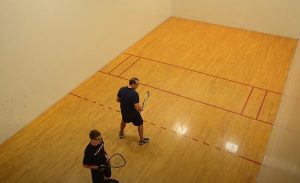
An indoor racquetball court consists of a front wall, a back wall, two side walls, a ceiling, and a floor.
Whereas an outdoor racquetball court has no ceiling and back wall and is surrounded by side walls of different sizes.
Some outdoor courts are without side walls and have only one front wall. One wall racquetball is a famous outdoor court.
The court is 40 feet long, 20 feet wide, and 20 feet high. There are many lines on racquetball courts as compared to other sports.
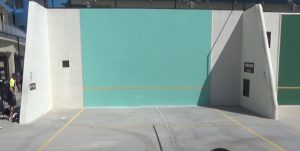
First, there is a short line that intersects the court halfway between the front and back walls.
Five feet in front of it is the service line.
The surface zone is the area between the short line and service line, where the server must serve from Five feet behind the short line is a receiving line.
Receiving players must stand behind this line while a server serves his hit. Similar to tennis, a player must serve the ball so that it reaches past a certain point.
In this game, the ball must hit the front wall and then make it past the short line before bouncing on the court.
3. Racquetball Ball; Types, Size, Weight & Speed
In racquetball, you can have a lot variety of racket balls. You can have balls of different colors (red balls, blue balls, and often a pink ball for collecting donations to fight against breast cancer) at different speeds and different weights.
You can choose different balls that might fit your game style.
You can go with one of the fastest balls that you carry, which is the pin ballistic ball.
This ball is tailor-made for those who are not good at hitting the ball with power. Now, moving on to another ball, specifically made for outdoor.
The outdoor ball is very durable and fast as a pen ballistic ball. It can face brutal shots and collisions with the cemented walls of an outdoor court.
Another ball is by Wilson. This ball is awesome with pink color. Another ball that is widely used is the pro pen ball.
This ball is used in national events, the singles and doubles, and so on.
4. Racquetball Shoes
These shoes are made especially for racquetball, with a kind of a gum soul that sticks to the wooden surface of the racquetball court, and for those quick movements, while playing, you don’t want to be sliding all over the surface of the court.
All you might be desiring is the durability, grip, lightness, price, and above all, the quality of the shoes.
No one can ever compromise on the quality of the shore.
Normally, racquetball shoes come with guaranteed durability, which is the demand of the players.
It’s you who chooses the befitting shoes for yourself. Assess them thoroughly and then finalize them.
5. Racquetball Eye Guards
Eye guards or goggles are the most important item that you can possibly get when playing racquetball.
They save your eyes from being hit by the ball or by your opponent.
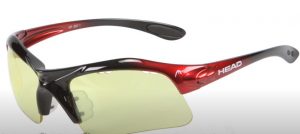
The eyes are one of the most precious assets. They not only save your eyes but also make you look hot and very attractive.
Don’t wear them outside of racquetball, these are game-specific accessories.
6. Racquetball Gloves
A glove may seem like an unimportant accessory for racquetball, but nothing could be more untrue.
You see, hitting the ball with such great force can add a lot of strain to your hand. Prolonged strain can wreak havoc on your body and subject your hand to blisters or even wrist injury.
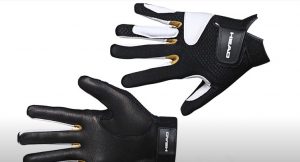
A good racquetball glove will protect you from painful blisters that can keep you on the sidelines for weeks.
It will even help to stabilize your wrist and prevent a sprain or other injury.
Racquetball Tips & Techniques for Beginners to Advanced Playing
Racquetball is a game that entails practice, physical fitness, agility, and brisk movement. The player, who is well equipped with all the necessary techniques, will prove to be a tough contender on the court.
Here are a few tips one can start with.
You will need a racket (with a wrist placer), a ball, high guards, and some good court shoes.
One of the first things to note. If you are a beginner, you should concentrate on two things. One turning sideways.
It means facing your hips and your feet towards the side wall when you hit and swinging level forehand.
You should play stroke by having your hips and shoulders sideways.
Finish it with a balanced position so as to move to a ball that is up. You have to do what is called a shuffle. Shuffle means to make your swift moves by changing your positions.
When you get to the ball, you are already a sideways shuffle.
The last tip for beginners is watching the ball.
Though it sounds simple, you want to watch the ball when you hit it and also when your opponent hits it.
You have to keep your eyes down where the ball is the whole time.
The second thing to do is to watch the ball; when your opponent hits it, that is it.
For this, is to pretend you have an eye on your left shoulder, whatever side the balls are, and always keep one shoulder and your two eyes on the ball.
One thing you don’t want to do is just face forward and wait to see the ball in your peripheral vision.
That makes you are active player not a proactive player so try those next time you play.
Racquetball Questions (FAQs)
1. How long does Racquetball last?
Normally, a standard racquetball game continues for 20 minutes. A match consists of games. So, the two games will end in 40 minutes, excluding break time.
A player who reaches 15 points wins the game.
In case a match of two games ends in a draw (each player gets equal points), the third game of 11 points is played to declare the match winner. The third decisive game increases the duration of the game.
Where is Racquetball Safety Zone?
The safety zone is a 5 by 24 area represented by two lines. This comes between the short line of the service box and dotted lines.
The primary purpose of the safety zone is to protect the server. The safety zone prevents the receivers from rushing in and potentially hurting the server.
3. What is a rally in Racquetball?
A rally is normally an exchange of shots between two rival players or teams. It starts with the serves and ends with the swing and miss of shots by either mistake or intention.
A player loses a rally when he fails to properly respond to the shot of his opponent.
A rally results in the change of the server. Remember, only the server can score points in racquetball. So, one had better play prudently and retain the rally.
4. What Is A Jam Serve In Racquetball?
The jam serve is one of the offensive, and uniquely serves in racquetball. It is common in singles and doubles.
It is played to make your opponent go off balance and helpless to respond to it. This shot makes first contact with the floor in the center and then near the back wall.
